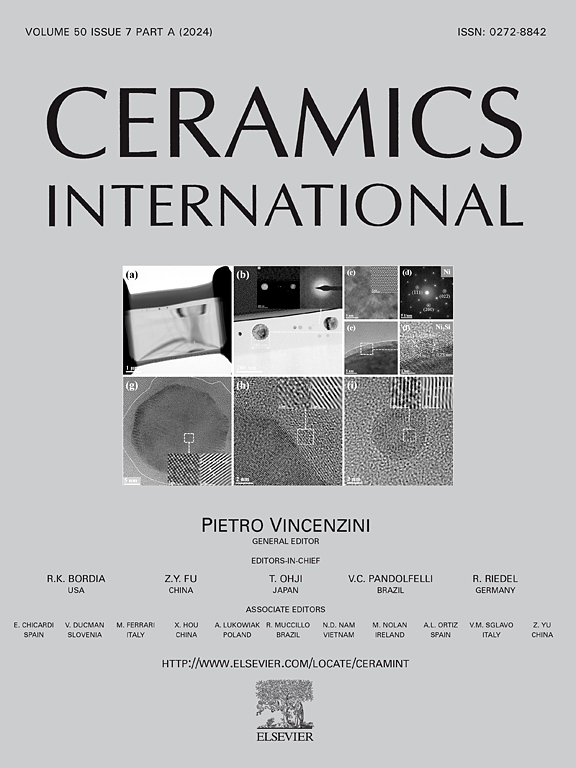Thickness modulation influenced mechanical properties of TiN/(CrVTaTiW)Nx multilayer coatings
IF 5.1
2区 材料科学
Q1 MATERIALS SCIENCE, CERAMICS
引用次数: 0
Abstract
A novel TiN/(CrVTaTiW)Nx multilayer coating, consisting of the high-entropy alloy nitride and the binary nitride was prepared by DC magnetron sputtering. Detailed investigation about the microstructure and mechanical attributes of the multilayer films was conducted, with particular emphasis on the influence of high entropy nitride (HEN) modulation layer's thickness. The results reveal that all samples exhibited a face-centred cubic (fcc) crystal structure with a (111) preferred orientation. Notably, the hardness and elastic modulus of multilayer films increase with increase of the HEN layer's thickness. When the thickness of the HEN layer reached 4.8 nm, the hardness and elastic modulus of the TiN/(CrVTaTiW)Nx multilayer reached the maximum values of 25.33 GPa and 311.95 GPa, respectively. These results indicate the key role of the HEN layer as a modulation layer within the coating, ultimately demonstrating the importance of thickness on the structure and properties of TiN/(CrVTaTiW)Nx nanomultilayer films.
厚度调节对 TiN/(CrVTaTiW)Nx 多层涂层机械性能的影响
通过直流磁控溅射制备了一种新型 TiN/(CrVTaTiW)Nx 多层涂层,该涂层由高熵合金氮化物和二元氮化物组成。研究人员对多层薄膜的微观结构和机械属性进行了详细调查,并特别强调了高熵氮化物(HEN)调制层厚度的影响。结果表明,所有样品都呈现出以 (111) 为优先取向的面心立方(fcc)晶体结构。值得注意的是,多层薄膜的硬度和弹性模量随着 HEN 层厚度的增加而增加。当 HEN 层的厚度达到 4.8 nm 时,TiN/(CrVTaTiW)Nx 多层膜的硬度和弹性模量分别达到 25.33 GPa 和 311.95 GPa 的最大值。这些结果表明了 HEN 层作为涂层内的调制层所发挥的关键作用,最终证明了厚度对 TiN/(CrVTaTiW)Nx 纳米多层膜的结构和性能的重要性。
本文章由计算机程序翻译,如有差异,请以英文原文为准。
求助全文
约1分钟内获得全文
求助全文
来源期刊

Ceramics International
工程技术-材料科学:硅酸盐
CiteScore
9.40
自引率
15.40%
发文量
4558
审稿时长
25 days
期刊介绍:
Ceramics International covers the science of advanced ceramic materials. The journal encourages contributions that demonstrate how an understanding of the basic chemical and physical phenomena may direct materials design and stimulate ideas for new or improved processing techniques, in order to obtain materials with desired structural features and properties.
Ceramics International covers oxide and non-oxide ceramics, functional glasses, glass ceramics, amorphous inorganic non-metallic materials (and their combinations with metal and organic materials), in the form of particulates, dense or porous bodies, thin/thick films and laminated, graded and composite structures. Process related topics such as ceramic-ceramic joints or joining ceramics with dissimilar materials, as well as surface finishing and conditioning are also covered. Besides traditional processing techniques, manufacturing routes of interest include innovative procedures benefiting from externally applied stresses, electromagnetic fields and energetic beams, as well as top-down and self-assembly nanotechnology approaches. In addition, the journal welcomes submissions on bio-inspired and bio-enabled materials designs, experimentally validated multi scale modelling and simulation for materials design, and the use of the most advanced chemical and physical characterization techniques of structure, properties and behaviour.
Technologically relevant low-dimensional systems are a particular focus of Ceramics International. These include 0, 1 and 2-D nanomaterials (also covering CNTs, graphene and related materials, and diamond-like carbons), their nanocomposites, as well as nano-hybrids and hierarchical multifunctional nanostructures that might integrate molecular, biological and electronic components.
 求助内容:
求助内容: 应助结果提醒方式:
应助结果提醒方式:


